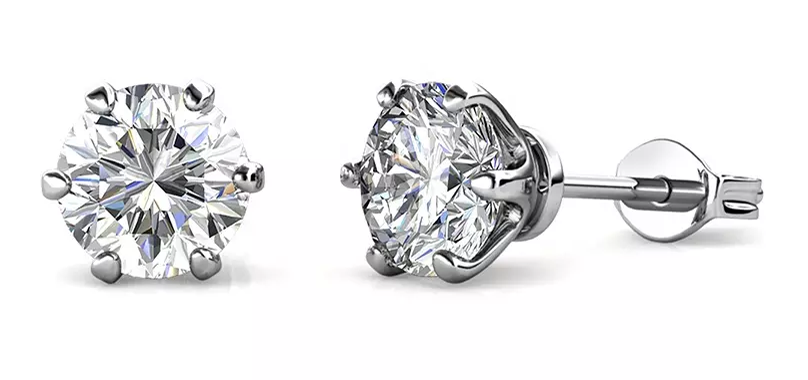Pearl Education
Pearls are one of only a handful of organic gemstones. They are formed by shelled mollusks, both naturally in the wild and through cultured "pearl farms". In the early 1900s, pearls were exclusively for the noble and wealthy giving pearl jewelry an aura of class and power. Today, pearl jewelry is still seen as a classic style perfect for formal occasions, but you'll see pearl jewelry creeping into everyday jewelry too at a much friendlier cost. Pearl is the birthstone for the month of June and a must have for every jewelry lover!

Color
When you think pearls, you immediately think of the classic white pearl necklace. But did you know that pearls can range in a variety of colors, from white to cream, yellow to red, gray to black, and even blue, green, or purple! The type of mollusk determines the pearl color, but pearls can also be dyed to achieve more vibrant or unnatural colors. A pearl's color includes both the body color and it's overtone (think of that as blush in your make-up routine - it doesn't change the underlying color, just adds a whisper of color over top).
Luster is the quality of the light reflected from a pearl’s surface and the pearls inner glow. It is arguably the most important factor in determining a pearl's value and beauty. The longer a pearl is allowed to grow, the thicker the coating of nacre around its center, giving fine pearls their glow. The higher the luster the sharper the reflection and refraction of light. Luster is typically described from high to low.
Pearls range in a variety of colors and characteristics including:
|
Akoya Pearl |
Bead-nucleated Cultured Pearl produced from akoya oysters, primarily in Japan and China, and also from Vietnam, South Korea and Australia. |
|
Abalone Pearl |
Pearl found in the mollusk haliotis. These Pearls are often an iridescent bluish color and commonly horn-shaped. |
|
Black Pearl |
Any Pearl that is dark in color. Black Pearls are usually synonymous with Tahitian Pearls. Black Pearls are often dyed. |
|
Cortez Pearl |
Dark Pearl grown in the pinctada maxima and pteria sterna mollusks in Mexico off the Gulf of California. |
|
Cultured Pearl |
Pearl grown with the influence of human intervention, in which a nucleus material is inserted into an oyster or mussel, and the Pearl forms over this material. |
|
Freshwater Pearl |
Pearl that grew in a non-saline environment in a freshwater mussel. |
|
Keshi Pearl |
Pearl formed when an oyster rejects an implanted nucleus before the culturing process is complete. |
|
Mabe Pearl |
Rounded Pearl that grows attached to the inside of the oyster's shell, rather than within its tissue. |
|
Melo Pearl |
Rare form of Pearl from Southeast Asia that is formed from a marine snail called melo melo. Although technically not considered a true Pearl as it didn't form within a mollusk, Melo Pearls are often regarded Pearls due to their formation in an organic marine environment and similarity to Pearls. |
|
Natural Pearl |
Pearl that is formed from calcium carbonate secretions that form naturally within a mollusk without any human intervention. This term is distinguished from the more common Cultured Pearls which are produced with human intervention. |
|
Saltwater Pearl |
Pearl produced by a mollusk such as an oyster in a body of saltwater such as the ocean. |
|
South Sea Pearl |
Pearl produced by the pinctada maxima mollusk. South Sea Pearls are highly regarded and cultured in areas throughout the Indian and Pacific Oceans, primarily in Australia, the Philippines, Indonesia and Burma |
|
Tahitian Pearl |
Highly regarded type of Pearl, cultured in the vicinity of the South Pacific Island of Tahiti and other French Polynesian islands |
Pearls are formed in a variety of shapes, including round, button, pear, drop, and more. Pearl size varies depending on how long the pearl is left within the mollusk. Larger pearls are more valuable as they take many years to form. There's no right or wrong to choosing your pearl shape or size. Instead, it's all about finding the pearls that bring you joy!

Pearl Matching
Pearl matching is an evaluation of the complete appearance of a pearl strand, pair or multi-pearl piece of jewelry. Matching can include size, color and quality. A well-matched strand is composed of pearls that complement each pearl above and below, and directly across as the strand drapes.
Pearl matching does not mean that all of the pearls are completely identical, nor does it mean that all of the pearls in the piece are generally uniform in size, shape, and color. It consist of pearls that fit together in uniform manner, and that variations among them are either minimal, gradual, or for a specific purpose.














